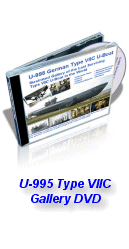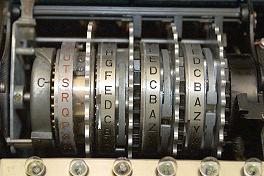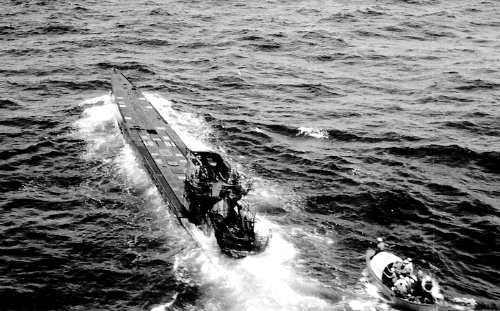

|
Enigma
The Enigma is made up of a keyboard, a scrambler and a lamp panel. The lamp panel contains the full set of 26 alphabets. When a letter is pressed on the keyboard, electric current is passed through the scrambler. The original letter is encrypted and a new letter is shown by a lighted lamp on the panel. The new letter could be any other alphabet, except the original letter itself. Usually the encoding of messages is done by two persons. One operated the machine and typed the message, while the second observed the lamps and recorded the letters as they showed up. The final encrypted message is then transmitted using morse code. When the message is received, the encrypted letters are keyed into the Enigma, and similarly, a second operator observed the lamps as they lit up and recorded the letters, revealing the actual message.
 |
 |
The keyboard and lamp board had 26 alphabets, which were laid out in German keyboard format (which is different from the English/American format). There were no numbers or punctuation marks, just the 26 letters of the alphabets. Numbers and punctuations marks had to be spelled out.
Q W E R T Z U I O
A S D F G H J K
P Y X C V B N M L
The scrambler unit consisted of three rotors, with each rotor having a set of 26 letters printed in a circular manner. Since each rotor was capable of 26 different positions, therefore three rotors combined would enable a combination of 17,576 possibilities (26 x 26 x 26). Later a fourth rotor was added, increasing the total possible combinations to 456,976. Before the scrambler could function, the operator had to set the starting position of the rotors. It is imperative that both the sending and receiving parties use the same starting position, otherwise the message could not be decrypted. When a key was pressed, the rightmost rotor would advance by one letter or 1/26th of a revolution. When one complete revolution was reached, the middle rotor would advance by one letter. Similarly, when the middle rotor completed one revolution, the leftmost rotor would advance by one letter. This ensured that identical letters in a single message would never be represented by the same letter twice.
The setting which indicated the starting position of the rotors was known as the Naval key (Schlussel M). There was a different key for each calendar day and every day at 12pm German time, the naval key would change. It was also possible to change to a different key at random intervals, which depended on the situation. When a U-boat sailed, the captain would be given the naval keys sufficient to cover the anticipated patrol time. If a U-boat stayed on patrol longer than expected, it would need to obtain a new set of keys from another boat, otherwise it would be impossible to send or receive encrypted messages.
These Naval keys were highly top secret, and were issued on a tightly controlled basis, for capture of the keys and the Enigma device would mean that encrypted communications were open to the enemy until the keys had expired. The naval keys themselves were printed on water soluble paper, which would dissolve itself when dropped in the bilges.
The Enigma was used by all branches of the German armed forces during World War 2. To contain the damage in the event that Enigma was compromised, each branch of the military used their own set of Enigma keys, with the Kriegsmarine model being designated Enigma M (M=Marine [navy]). Enigma M was itself further divided into four keys; the first was Hydra for warships in foreign waters, the second was Heimisch for warships in home waters, the third was Werft for shipyards and finally the fourth was Triton, exclusively for U-boats. There were many other specialized keys introduced for other purposes throughout the war.
Most messages were designated as Allegemein (general) or Offizier (officer only). General messages were encrypted using the normal daily key whereas “Officer Only” messages contained highly sensitive information and was double encrypted. The message would first be encrypted using the Offizier key, and encrypted again using the Allegemein key. The first words revealed were “officer only”, and once the radio operator had decrypted the first message, it would be handed to the communications officer. The officer would then use the Offizier key to decrypt the second encryption in private.
The Germans considered the possibility of the allies breaking the Enigma as highly improbable. However, several highly unlikely incidents took place which had aroused Donitz’s suspicions that the allies were reading Enigma messages. Several investigations were launched at Donitz’s insistence, but the Naval intelligence had always reached at the same conclusion. That breaking of the Enigma was impossible. What the Germans did not know however, was that the Enigma machines were captured intact together with the naval keys, which were of great help to British codebreakers. Instead, these incidents were attributed to espionage and the effectiveness of allied radar. Nevertheless, Donitz took precautionary measures which resulted in the introduction of the four-wheel Enigma on February 1942. This greatly complicated the British codebreakers’ effort, but soon the four-wheel Enigma was also captured, and by December 1942, the allies were again reading Enigma messages. A further precautionary measure Donitz had taken was to implement a system of encoding map grids. Instead of transmitting the actual grids, these were encoded using a simple code which was changed at irregular intervals. To decipher the actual grid, the navigator used the encoded grid and calculated a certain offset, which would reveal the actual location.

|
| The capture of U-505 along with the enigma and top secret papers were of immense help in the British codebreaking effort. Note the boarding party approaching the U-boat. |



